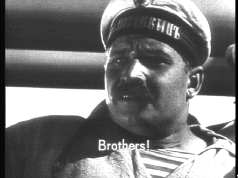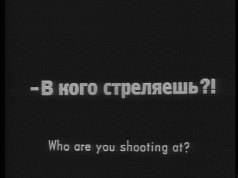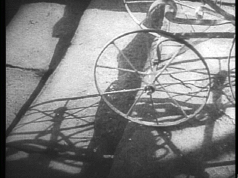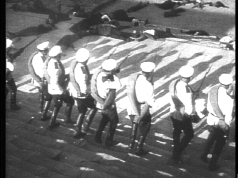Bronenosets
Potyomkin ( Battleship Potemkin )(1925)
Directed
by
Grigori
Aleksandrov
Sergei M. Eisenstein (1898-1948)
NOTE: DVD EDITIONS ARE COMPARED HERE
REVIEW
BY GARY TOOZE
Probably one of the most
surprisingly unwatched of the classic genre films, Sergei Eisensteinís
Bronenosets Potyomkin ( Battleship Potemkin ) made in 1925 has not maintained a
distinctive impact on modern audiences. It was voted the greatest film of
all time at the Brussels, Belgium, World's Fair in 1958 and the following year
``Citizen Kane'' had its giant re-release and went to the top of the list for
the next 40+ years.
Battleship Potemkin was
restored in Moscow in the mid 70ís. and there
is no mistaking the age of the source material on the Image Entertainment DVD,
but the print is in acceptable condition and its scratches and flaws do not
inhibit the films viewers experience, in fact that can tend to supplement it. We
are not only watching a storyline, but also history. Political and Cinematic.
The monophonic orchestral musical score, by Dimitri Shostakovich, is quite nice
as well with occasional unusual pauses and stoppages.
The level of appreciation for
the film depends on oneís tolerance of endeavoring to accept the numerous
symbols and parallels administered through typical over exaggerated silent film
acting. Eisenstein himself represents The Church as
he plays the wild looking Russian Orthodox chaplain. It
is hard to pinpoint actual flaws in the acting due to the style in which the
film is made, often at a blisteringly edited pace with no focus on any
individual characters. . D.W. Griffith and such films of his as ďIntoleranceĒ,
1916, ( which I believe is out of print on DVD ) heavily influenced the film
Battleship Potemkin. Not unlike the
propaganda message it delivers, BP fittingly never focuses on an individual
behavior for long, but rather the whole persona and often harried and violent
activities that are being shown before our eyes. There are no three dimensional
individuals in the story who may cause it to become personalized. The only real
star of the film is stated in the title.
Eisenstein became quite focused
on the actual Potemkin mutiny that his film is based. The crews of the
battleship, sailing through the Black Sea after returning from the war with
Japan, become outraged because of tainted rations and uncaring bourgeois
officers. After a cloth, their death shroud, is thrown over a small group of
defiant sailors and orders are shouted for them to be shot. The tension mounts
for the viewer and the films potential protagonist Vakulinchuk cries out,
``Brothers! Who are you shooting at?''
( CLICK ON IMAGES FOR LARGER VERSIONS )
His
simple act of imploring for justice to be done was all that was required to
start the massive uprising. The firing squad lowers its guns and a melee breaks
loose as officers, the shipís doctor and maggot infested meat are hurtled
overboard. Vakulinchuk dies in the foray and becomes an important martyr symbol.
Note:
The Battleship Potemkin
was made on the 20th anniversary of the war with Japan made with the cooperation
of the Russian Navy. Historians may take interest that actual Russian sailors
are shown operating the battleship controls.
The most famous of scenes in the film is, of course, the slaughter on the Odessa steps. Word of the sailors uprising has reached the port of Odessa where more individuals of all economic stature and breeding are supportive of their efforts with boatloads of fresh farm animals and food sent out to the meet the Potemkin.
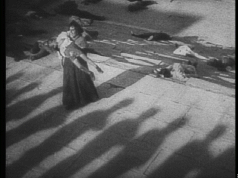 |
Quite soon the support ends as the faceless military Cossacks come firing in unison at the crowd on the steps. . |
Brian De Palma, perhaps more famous for imitating Alfred Hitchcock, found his most famous scene, which he duplicated in ďThe UntouchablesĒ, as an unguarded baby carriage bounces slowly down the steps as the masses run from the gunfire. Innocent civilians and children are slaughtered without remorse.
( CLICK ON IMAGES FOR
LARGER VERSIONS )
Eisensteinís masterful use of
symbols, concepts and montage theory editing, forgoing character development and
individuality, have created something so far away from the sporadic flashes of
sex and violence that have infiltrated the television and movies of todayís,
aptly named, X-Generation. I enjoyed the film for its story and historical
meaning in cinema, but am also saddened that so many, including my younger
girlfriend, will never see it or have any desire to. The turning of the century
has further distanced so many with its bombardment of quick gratification and
image stimuli, who could not hope to appreciate the impact of Battleship
Potemkin simply giving it the opportunity to speak. I recommend it quite
strongly to all budding film buffs and film students before, like many other
classics, it becomes unavailable.
NOTE: DVD EDITIONS ARE COMPARED HERE
Bronenosets
Potyomkin ( Battleship Potemkin )(1925)
Directed
by
Grigori
Aleksandrov
Sergei
M. Eisenstein
Writing
credits
Nina
Agadzhanova
Sergei
M. Eisenstein
Credited
cast overview:
I.
Bobrov .... Salior
Beatrice
Vitoldi .... Woman With Baby
Carriage
N.
Poltavseva .... Woman With
Pince-nez
Julia
Eisenstein .... Odessa Citizen
rest
of cast listed alphabetically
Grigori
Aleksandrov .... Chief Officer
Giliarovsky
Aleksandr
Antonov .... Vakulinchuk
Vladimir
Barsky .... Commander Golikov
Sergei
M. Eisenstein .... Ship Chaplain
Mikhail
Gomorov (I) .... Sailor
Aleksandr
Levshin .... Petty Officer
Also
Known As:
Battleship
Potemkin, The (1925) (USA)
Battleship
Potyomkin, The (1925) (USA: alternative transliteration)
Bronomzidi
Potiomkini (1925) (Soviet Union: Georgian title)
Potemkin
(1925) (USA)
‚“ŌőŇőŌ”Ň√
ūŌ‘£Õň…ő (1925) (Soviet Union: Russian title: original Cyrillic KOI8-R
title)
Runtime:
Russia:75 / UK:75 / USA:66
Country:
Soviet Union
Color:
Black and White
Sound
Mix: Silent
Certification:
Finland:K-16 (1952) / Netherlands:AL (video release) / Sweden:15 / UK:U /
USA:Unrated
